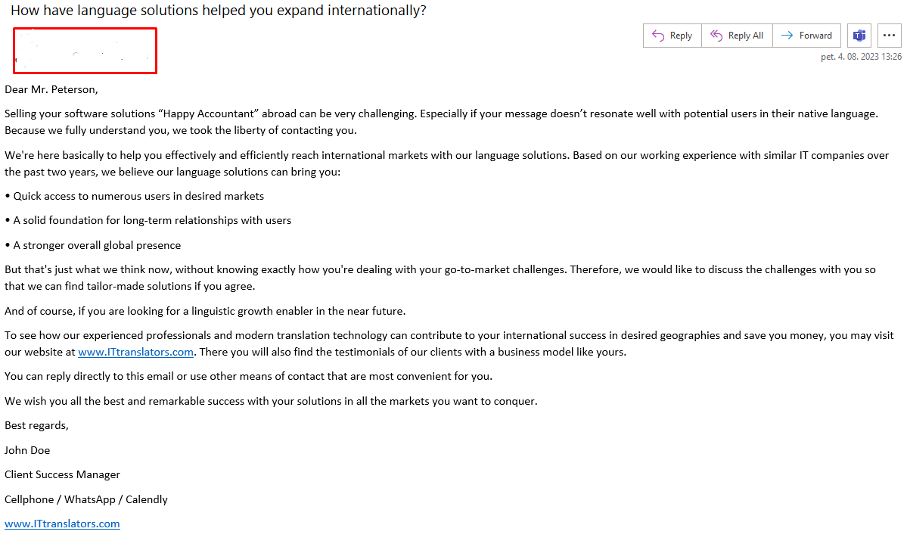- Home
- Resource Center
- Articles & Videos
- How to Write Successful Sales Emails for Translation Services in 2023
8 August 2023
| by PROFECTA BDI
How to Write Successful Sales Emails for Translation Services in 2023

Sign up for our newsletter on globalization and localization matters.
I am quite sure you've received at least one email from a translation service provider regarding translation services you don’t need, never asked for, or even you yourself provide. Not customer oriented at all. On top of that, the email was probably full of spelling and grammatical errors.
Obviously, no research was done. And no email content quality check was carried out to showcase authority and credibility already through the email to highly error-sensitive recipients. For sure, a lot can be learned from such emails.
But let’s focus on what you can do better to reach clients who need reliable translation service providers.
Email marketing is not dead
In addition, such an email may have even reinforced your limiting belief that email marketing is dead and you may have deleted it right away. However, the figures presented by MailerLite show the opposite. Surprisingly enough, as many as 37.65 % of recipients opened a sales email in 2022. Here is a bit more of their statistics for 2022:
Email marketing benchmark across industries
|
0.30% |
0.24% |
8.93% |
3.36% |
37.65% |
|
Bounce rate |
Unsubscribe rate |
Click-through rate |
Click rate |
Open rate |
Source: MailerLite
Since sales emails seem to be alive and kicking, let’s see how you can write successful emails specifically for your translation services. Success here equals converting recipients into clients once they need translation services.
Don't sell, request an appointment
Before we dig into email writing, please note that sales emails should not push anyone to buy your translation services. In principle, their function is to remind potential clients that you can help them achieve their goals or solve their problems with your language solutions once the need arises.
Instead, focus on building a relationship with your prospective clients. Politely ask for an appointment to discuss their needs and challenges further. Frame the appointment as an opportunity to explore potential solutions together, rather than a pushy sales attempt. This approach shows that you are genuinely interested in understanding their unique requirements and are eager to provide tailor-made solutions.
No success without a strategy and thorough preparation

Success requires strategy and thorough preparation because your message needs to be communicated effectively for ideal clients to even want to open your email. And that they are motivated to further research who you are and how you can make their lives easier.
For this purpose, I will use the PDCA approach (Plan-Do-Check-Act) here to make your life easier. You'll find out how you can:
- excel in the planning and preparation phase (plan)
- test the waters with a smaller audience (do)
- analyze the testing data (check)
- apply the findings to the larger audience (act)
Planning and preparation phase
Strategically consider the points listed below first.
Goals and purpose:
- Your overarching business goal and how the email campaign fits into the big picture
- Purpose of the email: informing or nurturing
- Measurable goals of this email campaign and results you’ll be happy with
Audience:
- Target audience you can serve impeccably right now
- Unique value proposition that fully resonates with your ideal clients
- Three benefits that address the pain points of your ideal clients
- Communication style and tone of voice
- Clear, compelling and descriptive call-to-action
- The ideal email length that should be less than 200 words
Technology and legislation:
- Platforms to find the right contact in desired segments such as country business registers or business intelligence solutions such as Dun and Bradstreet
- Email marketing tools like MailerLite or Mailchimp
- Compliance with email marketing regulations such as GDPR (EU), CCPA (US), CASL (CA)
Know your target audience
Before hitting "Send," you may take the time to understand your target audience thoroughly. Who are they? What industries do they belong to? What are their pain points and challenges?
For example, if you want to work with IT startups, you might think about approaching people who oversee strategy development or make strategic expansion decisions. It can be CEO or marketing department or someone you would have never expected. Research is the backbone of any successful sales email.
Understand their current and future needs
While some potential clients may not require translation services immediately, they might in the future. Translation service providers should be aware of this and position themselves as reliable and trustworthy partners who can support their language needs whenever they arise.
Create an attractive subject line and pre-header message
You can make the first impression only once, especially when it comes to email communication. People receive countless emails daily, and if the subject line and pre-header (the short summary text that follows the subject line) fail to capture their attention, the chances are high that your message will go unnoticed.
Make the subject line appealing, concise, and relevant to the recipient's interests. It can even be a thought-provoking question such as:
How have language solutions helped you expand internationally?
However, you can find inspiration here for different types of email subjects.
In the pre-header, address their pain points directly, showing them that this email is not just another generic sales pitch, but a tailored solution to their specific needs. For IT startups, it can be something along the lines:
Dear Mr./Ms. XXXX,
Selling your software solutions XXXX abroad can be very challenging. Especially if your message doesn’t resonate well with potential users in their native language. Because we fully understand you, we took the liberty of contacting you.
Utilize the power of three benefits
In the body of the email, focus on presenting three key benefits of your translation services. The reason for this is simple: people tend to remember and process information better in threes. It keeps the message clear and memorable.
Client’s language is the key
ALWAYS use the language of your ideal clients and never insist on words used for specific translation services such as localization, post-editing and the like because many people don’t know what they mean. So, if you are writing to a marketing person, use the words such as “part of your marketing strategy”, “go-to-market challenges”, “addressing customer segments properly”, and “success in different markets”.
If you are talking to IT professionals then use phrases “it is like big data”, “analytical approach”, “to stay agile”, “to improve marketing automation”, etc.
In this way, you also show your empathy. But don’t forget to also show your authority to help them based on your experience with similar companies, specific know-how, and modern technology that will also help them save some money. Empathy and authority together make up the most needed customer orientation.
Showcase translation as a growth enabler
Position translation services as more than just a transactional service; emphasize that it serves as a growth-enabling resource for the client's business. By demonstrating the transformative impact of translation, you showcase your services as an investment rather than an expense.
So you may go on like this:
We're here basically to help you effectively and efficiently reach international markets with our language solutions. Based on our working experience with similar IT companies over the past two years, we believe our language solutions can bring you:
• Quick access to numerous users in desired markets
• A solid foundation for long-term relationships with users
• A stronger overall global presence
But that's just what we think now, without knowing exactly how you're dealing with your go-to-market challenges. Therefore, we would like to discuss the challenges with you so that we can find tailor-made solutions if you agree.
And of course, if you are looking for a linguistic growth enabler in the near future.
To see how our experienced professionals and modern translation technology can contribute to your international success in desired geographies and save you money, you may visit our website at XXXXX. There you will also find the testimonials of our clients with a business model like yours.
You can reply directly to this email or use other means of contact that are most convenient for you.
We wish you all the best and remarkable success with your solutions in all the markets you want to conquer.
Best regards,
John Doe
Client Success Manager
Cellphone / WhatsApp / Calendly
LanguageSolutions.xxx
Testing the waters with a smaller audience
Now that our email is ready, it's time for the Do phase of the Plan-Do-Check-Act approach to writing successful sales emails for translation services. In this phase, you may want to test how your email resonates with a smaller audience before going big.
Technically, this is your pilot project. To be on the safe side, you should first send the email to yourself or to your colleagues with different email accounts (Gmail, Outlook, Apple Mail, etc.) to get the look and feel in the different email clients. The example from this blog looks like this:

Then you can select eight to ten contacts and maybe test two different subject lines to see which one has a higher open rate. That's technically called an A/B split campaign, and you can read more about it here.
For this purpose, you can also use email marketing tools like MailerLite or Mailchimp, because they give you access to statistics about emails opened and links clicked in them, as well as some other useful numbers.
Analyze your data
OK, now we are in the Check phase of the Plan-Do-Check-Act approach. Now that you have more information from your pilot and know your target audience better, it's time to analyze what went well and what can be transferred to a larger group or recipients.
Review the effectiveness of your subject line and content, starting with the headline, the body of the email and the call-to-action. Make the necessary corrections and you're ready for the big show.
Apply the findings to the larger audience
At this stage, you are ready to go to the big group. But that doesn't mean this is the end of the email campaign. Everything you do here you can apply in the next iteration as you will have more insights again. It's important that you enjoy the game and play it fairly and safely.
All’s well that ends well

In summary, creating successful sales emails for translation services requires a thorough preparation, execution and persistence. Good luck growing your translation business!

Zoran Metikoš
I help language service providers (LSPs) grow as businesses and their employees grow as professionals by providing unique business development consulting and growth mindset coaching for executives and middle managers. My company, Profecta BDI, not only helps LSPs find new clients, but also grow as companies, professionals and individuals. The stability of the company and a good corporate culture are the foundation for growth. After graduating in Linguistics and Translation in 2003, I started working as a translator and translation tool trainer in SAP localization and eventually worked as a project coordinator, business developer and operations manager at LSPs for 17 years until 2020. After completing my MBA at the School of Business and Economics in 2015, I came up with the idea of helping many LSPs grow and learn how to develop as businesses and professionals. I'm also a certified professional coach and NLP Master Practitioner.


